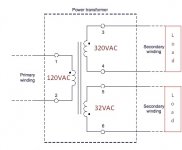While poking around trying to do some measurements in my Peavey Classic 30 guitar amp hooked up to a dummy load, I stupidly shorted the HT winding (point "3" in the attached diagram) to the lower voltage Filament winding (point "5").
This happened across a multimeter probe for all of about half a second.
The transformer, a Mercury Magnetics replacement PT, let out an unhappy mechanical "bzzz" sound but with no smoke or smells to speak of.
So, in my lay understanding, shorting the two points together created a "Series Opposing Secondaries" wiring, which left 320-32=288VAC on both of the secondaries? (Notice the lower secondary is 180 degrees out of phase with the top one).
Is this the right prognosis?
Tested each secondary's DC resistance - no shorted windings as far as I can tell. I also o-scope tested the transformer with dummy loads on the secondaries and it appears to be fine.
My real concern is that the low-voltage rated caps downstream from the filament winding are all suspect now that they have been exposed to such over-voltage.
Should I just assume that these caps are done for, even if they test ok?
Your help is greatly appreciated.
This happened across a multimeter probe for all of about half a second.
The transformer, a Mercury Magnetics replacement PT, let out an unhappy mechanical "bzzz" sound but with no smoke or smells to speak of.
So, in my lay understanding, shorting the two points together created a "Series Opposing Secondaries" wiring, which left 320-32=288VAC on both of the secondaries? (Notice the lower secondary is 180 degrees out of phase with the top one).
Is this the right prognosis?
Tested each secondary's DC resistance - no shorted windings as far as I can tell. I also o-scope tested the transformer with dummy loads on the secondaries and it appears to be fine.
My real concern is that the low-voltage rated caps downstream from the filament winding are all suspect now that they have been exposed to such over-voltage.
Should I just assume that these caps are done for, even if they test ok?
Your help is greatly appreciated.
Attachments
The low voltage secondary winding will have reduced the voltage from the high voltage secondary so you may have got away with it, especially as it was for such a short time.
I suggest you acquire a lamp limiter then use that to power up and check DC voltages. Listen for any fizzing or other strange noises, and see if anything seems hotter than usual. An IR temperature gun is best, but the human cheek also has IR receptors - but don't get too close and zap yourself! Smell too can be a useful sense with electronics.
I suggest you acquire a lamp limiter then use that to power up and check DC voltages. Listen for any fizzing or other strange noises, and see if anything seems hotter than usual. An IR temperature gun is best, but the human cheek also has IR receptors - but don't get too close and zap yourself! Smell too can be a useful sense with electronics.
Well, I tested the amp with dummy load(s) and it appears to be operating fairly normally, to a point anyway.
Surprisingly an IC op amp downstream from the 32VAC winding didn't burn out. Would this indicate that the voltage didn't actually spike on the lower winding?
What I am seeing, however, on my oscilloscope is a "bouncy" kind of behavior of the test waveform when taken from some of the plates in the preamp section. Oddly, this "bounciness" (for lack of a better term) doesn't seem to occur on the first 12AX7 plate.
I have my scope set to AC in and I corroborated the "bounciness" on both channels with two different probes, so I don't think it's the scope itself.
It seems like some issue to do with erratic DC, no?
As an aside, this is all compounded by the strong possibility that the output transformer is toast - what I was initially trying to test for when all of this other stuff "blew up in my face" (not quite literally, but you get the drift).
Thanks a lot for the help.
Surprisingly an IC op amp downstream from the 32VAC winding didn't burn out. Would this indicate that the voltage didn't actually spike on the lower winding?
What I am seeing, however, on my oscilloscope is a "bouncy" kind of behavior of the test waveform when taken from some of the plates in the preamp section. Oddly, this "bounciness" (for lack of a better term) doesn't seem to occur on the first 12AX7 plate.
I have my scope set to AC in and I corroborated the "bounciness" on both channels with two different probes, so I don't think it's the scope itself.
It seems like some issue to do with erratic DC, no?
As an aside, this is all compounded by the strong possibility that the output transformer is toast - what I was initially trying to test for when all of this other stuff "blew up in my face" (not quite literally, but you get the drift).
Thanks a lot for the help.
- Status
- This old topic is closed. If you want to reopen this topic, contact a moderator using the "Report Post" button.

